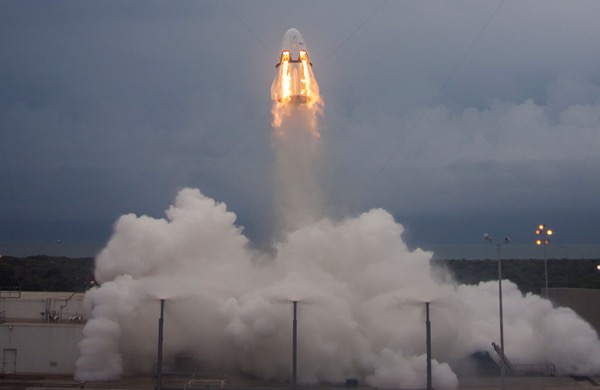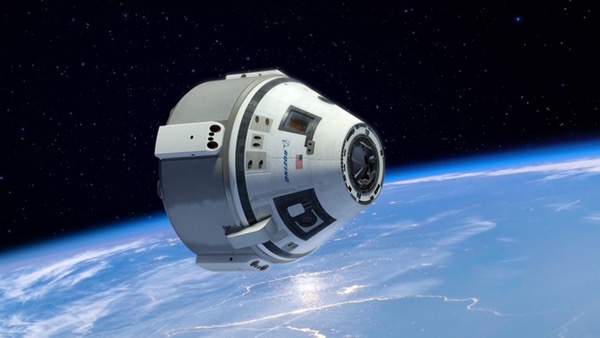The commercial crew crunchby Jeff Foust
|
| “We’ve still not fully funded our commercial crew effort, and it will delay our ability as a nation to be able to transport our astronauts to and from the International Space Station,” said Fattah. |
Moreover, the desire of the US to end its reliance on Russia to access the ISS seemed to be stronger than ever, thanks to both geopolitics and concerns about Russia’s technical capabilities, including the failure of a Progress cargo mission to the ISS in April. Surely, commercial crew supporters thought, it would be easier to win full funding for the program this year and keep the two companies on track to certify their vehicles by the end of 2017.
Well, so much for that.
Despite those factors, and dire warnings from NASA leadership that the program requires full funding to keep it on schedule, appropriators in the House of Representatives and the Senate have separately moved to cut hundreds of millions of dollars from the program in their fiscal year 2016 funding bills. If NASA is right, and if Congress doesn’t restore the funding later in the appropriations process, the program will suffer another delay.
The House took action first, drafting an appropriations bill approved by the commerce, justice, and science (CJS) subcommittee of the House Appropriations Committee May 14. That bill provides NASA with $18.529 billion for 2016, the same amount requested by the administration. However, the bill shifted funding among agency programs, and commercial crew took one of the largest hits: a reduction of $243 million to exactly $1 billion.
That funding level survived consideration by both the full appropriations committee May 20, and on the House floor, which left NASA funding levels intact during a two-day debate on the bill that concluded with a 242–183 vote, largely on party lines, June 3.
However, some members of the House expressed concern about the funding levels. “One of the challenges of the cap is that we’re not able to do all that we wanted to do, or need to do,” said Rep. Chaka Fattah (D-PA), ranking member of the CJS appropriations subcommittee, May 20. “We’ve still not fully funded our commercial crew effort, and it will delay our ability as a nation to be able to transport our astronauts to and from the International Space Station.”
The cap he referred to was the overall level of $51.4 billion allocated for the CJS funding bill, which had to support not just NASA but also the Departments of Commerce and Justice and other independent agencies like NSF. That was set as part of overall spending levels consistent with the Budget Control Act of 2011.
Fattah reiterated his concerns about commercial crew funding on the House floor in early June, and was not the only member to do so. “We must set priorities within the NASA budget to make sure that the American astronauts are launched from American soil on American vehicles sooner rather than later,” said Rep. Brian Babin (R-TX). Babin, whose district includes the Johnson Space Center, was recently named chairman of the House Science Committee’s space subcommittee.
However, neither Babin nor Fattah formally introduced amendments to increase commercial crew funding. The best they got was a promise by Rep. John Culberson (R-TX), chairman of the CJS appropriations subcommittee, to address the issue later. “I want to assure you that as we work through this process in conference and the additional funding becomes available,” Culberson said, “we are going to fill those holes and make sure that we are given as much support as we possibly can to commercial crew and to Orion.”
 SpaceX’s Dragon vehicle flies off the pad during a test of the capsule’s abort system at Cape Canaveral last month. The test was a milestone in SpaceX’s earlier commercial crew agreement, not its current contract. (credit: SpaceX) |
Senate appropriators took up their version of a CJS spending bill last week, with an even larger cut. Commercial crew received $900 million in a version of the bill approved June 11 by the committee, part of an $18.29-billion NASA allocation, $239 million below both the administration’s request and the House bill.
Unlike their House counterparts, Senate appropriators said little about the commercial crew portion of the budget. The overall bill, subcommittee chairman Sen. Richard Shelby (R-AL) said June 10, supports “a balanced space program within NASA.”
| NASA’s plans for buying Soyuz seats in 2018 indicates it “does not have confidence that even with significant financial and technical support, the availability of a reliable domestic ISS crew capability by 2017 is guaranteed,” the report stated. |
Sen. Barbara Mikulski (D-MD), the ranking member of both the CJS subcommittee and the full appropriations committee, did attempt to add funding for NASA and, specifically, the commercial crew program. She submitted an amendment to increase the overall bill by nearly $2.8 billion, including $500 million for NASA, $300 million of which would have gone to commercial crew.
However, the Republican majority on the committee opposed the amendment since it busted the budget caps. Shelby said he would be willing to revisit the proposed increases if a separate budget agreement, similar to the “Murray-Ryan” agreement two years ago that temporarily rolled back budget sequestration, was passed. “Since no agreement has been reached yet, I would have to oppose Sen. Mikulski’s amendment and urge my colleagues to do this at this time,” he said. The amendment failed on a 14–16 vote, on party lines.
The day before appropriators approved the bill, Sen. Bill Nelson (D-FL) spoke out against the cuts in commercial crew on the Senate floor, arguing that it would delay the development of commercial crew systems until as late as 2019. “If that cut in the subcommittee is sustained,” he said, “it’s going to delay us from being able to launch Americans on American rockets.”
Neither the House bill nor the report accompanying the bill explained why it cut commercial crew funding by 20 percent from the request. However, the report accompanying the Senate bill suggested that it concluded the program was already at risk of being delayed even if it was fully funded: “To date, milestones intended to show progress in the development of ISS Crew capability have already begun to be delayed,” the report states, without elaborating.
It also took issue with NASA plans, announced earlier this year, to acquire Soyuz seats for flights to the ISS in 2018, after when commercial vehicles are expected to be ready. NASA argued that the three-year lead time for Soyuz production required the agency to make a decision now about acquiring Soyuz seats to ensure it had access should both Boeing and SpaceX fall behind schedule for any reason.
Senate appropriators, though, took that move as a sign of a lack of confidence by NASA in the companies’ ability to remain on schedule. “Such statements are deeply concerning and indicate that even NASA, which has continual insight and oversight of the ISS crew program, does not have confidence that even with significant financial and technical support, the availability of a reliable domestic ISS crew capability by 2017 is guaranteed,” the report stated.
Advocates of commercial crew, though, see the statement and accompanying funding cut as a self-fulfilling prophecy. NASA administrator Charles Bolden has argued on multiple occasions that the original funding request of $1.243 billion is driven by the fixed-price contracts it awarded to Boeing and SpaceX last year. The contracts are milestone driven, and he warned that if there was not enough funding, the agency would have to renegotiate those contracts and delay the program.
“It is critical that we receive the funding requested for 2016 so that we can meet our 2017 target date and stop writing checks to the Russian Space Agency,” Bolden told members of the House Science Committee at an April 16 hearing, one example of many similar comments he has made calling for full funding of commercial crew.
| “The primary reason we’ve seen [for potential delays] is the lack of commitment on the part of the Congress to fund the program at the amount requested by the President,” Bolden said. |
At that same hearing, he argued against one alternative sometimes discussed to deal with any commercial crew shortfall or to accelerate the program: terminating the contract of one of the two companies. “The path on which we’re currently embarked, with two providers, maintains competition and it guarantees I will have the safest vehicle possible,” he said. “If we downselected to one, it would not speed up the process at all. It may even slow it down because that one provider becomes the monopoly that dictates to me what it can and can’t do, and what it will and won’t do.”
Later that same day, Bolden testified before the Senate CJS appropriations subcommittee, where he faced questions from Shelby about the commercial crew program that followed similar arguments as those mentioned in the later appropriations bill report, including reports of schedule slips and NASA’s decision to acquire Soyuz seats for 2018. “A lot of us are concerned by the potentially large number of changes and delays so soon in the program,” Shelby said.
Bolden responded that schedule changes were often due to a lack of funding by NASA, and reiterated the need for full funding for the program. “I have utmost confidence in both Boeing and SpaceX that they will meet their obligations, if we meet ours to pay the bill.”
“What has NASA seen so far in the continued development of our own crewed vehicles to justify paying Russia hundreds of millions of dollars for seats that should already be covered by the US providers if the US companies meet their milestones?” Shelby asked.
Bolden’s response was blunt. “The primary reason we’ve seen is the lack of commitment on the part of the Congress to fund the program at the amount requested by the President,” he said.
“The bottom line is, you need more money,” Shelby said.
“We only need what we asked for in the budget,” Bolden responded. “I’d be more than happy to take more, but we really need $1.2 billion in 2016.”
Right now, NASA isn’t getting $1.2 billion for commercial crew. However, the budget debate is far from over. The Senate has yet to take up the spending bill, and may not for some time—if at all—because of broader debates about spending priorities, including the budget caps of the Budget Control Act.
And even if the Senate does pass its bill, it will have to be reconciled with the House version. In the NASA section alone there are considerable differences. The House bill cuts funding for Earth science and increases it for planetary science, including $140 million explicitly identified for a Europa mission. The Senate bill, by comparison, follows the administration’s request for science more closely, and without the explicit Europa allocation.
Both bills, though, do increase funding for the Space Launch System by more than $500 million above the administration’s request, even though Bolden has previously said that additional funding would not accelerate the readiness of the SLS for its first launch, now planned for some time in 2018. The Senate bill also provides more than $100 million in additional funding for the Orion crew spacecraft, although the House sticks to the administration’s request.
That gives commercial crew’s advocates time to muster a defense of the program, both in public view and behind the scenes on Capitol Hill, something that has already started with a series of press releases by both members of Congress and advocacy organization. Even if they’re successful, though, recent events suggest there will be another budget battle over commercial crew next year.
